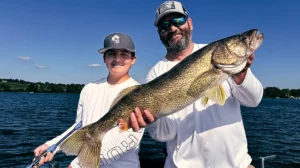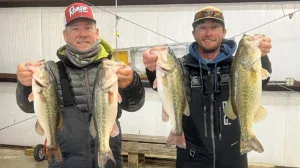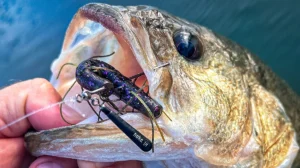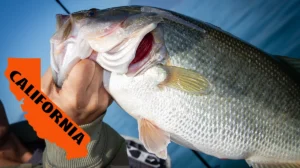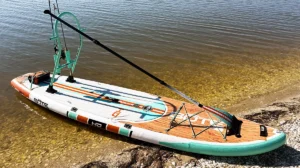Darold Gleason traded a steady career as a school teacher and basketball coach for that of a full-time fishing guide on Toledo Bend Reservoir.
He’s caught eight bass over 10 pounds from the famous reservoir, does very well as a Bassmaster Open competitor and hauled a 20-pound limit from the depths of Kentucky Lake on day one of BASSfest to sit in 19th place among the best pros in the world.
Soon after weighing-in, Gleason graciously taught a fast lesson in three essential things all anglers should consider to locate and catch largemouth in the post-spawn phase of early summer.
Take advantage of technology
“I use Down Imaging to locate the bass, which generally appear in groups of 5, 10, up to roughly 25 or 30 white dots near the bottom on a contour break or depth change,” Gleason said. “The Side Imaging portion of my sonar allows me to take a closer look at the sides of those depth changes to better understand how the bass are relating in detail to that spot.”
Boat position is critical
“You have to figure out exactly where to sit your boat in order to make a cast that will allow your lure to intersect the fish you’re seeing on sonar,” Gleason said. “The angle and distance of every cast you make needs to intersect that school of bass, or you’re obviously wasting your time.”
3 lures to utilize
“I’ll start with a 6th Sense Crush 500DD crankbait that will run 20 feet deep on 10-pound fluorocarbon,” Gleason said. “Then I’ll pick up a 3/4-ounce V&M Pacemaker Flatline Football Jig in green craw to clean up the less aggressive fish in the area. If things get tough, however, and that school of bass is sticking their lip out at you—you’d better have a 1/4-ounce drop shot rigged up with a watermelon candy-colored V&M Trickster Worm.”
Amid a fishing trip on the bass-starved Ohio River in the summer of 1987, Alan McGuckin’s Dad told a then 16-year-old “Guck” — “I don’t care what you do for a living, just promise me you’ll do something you love.”
Originally from Pittsburgh, McGuckin considers himself a blue-collar kid, who has been richly blessed to live-out the best piece of advice his dad ever gave him for many years now in the Tulsa area.
After earning a degree in ecology at Juniata College in Pennsylvania, where he placed radio transmitters in largemouth bass to track their habitat preferences, he moved his life to Oklahoma in 1992, where he earned a Masters in Zoology and Fisheries under the direction of Gene Gilliland at the University of Oklahoma, before then embarking on what’s now a nearly three decade long career as a marketing and media veteran in the fishing industry.
His career spans 28 years of wisdom-rich marketing experience working to strengthen brands and increase sales for Lowrance, Terminator Lures, Toyota, Yamaha Outboards, Boat U.S., Carhartt, Costa, Quantum, Vexus Boats, and Zebco.
- Member of the Bass Fishing Hall of Fame voting committee, as well as a Board of Directors member for Keep the Tennessee River Beautiful
- Co-piloted the Terminator brand of premium lures from its birth to more than 10 Million pieces sold between 1997-2006.
- Has authored and published more than 800 stories on Bassmaster.com, along with several other popular bass fishing websites.
- He has generated $3 Million dollars’ worth of branded digital media since 2020, as a content creator.
- Serves as emcee for hundreds of guests at the annual Toyota Bonus Bucks Owners event.
- Avid angler, who fishes nearly every weekend when not on the road working.
- 13,000 followers on Instagram @GuckFishing.
“Guck” lives just north of Tulsa, OK at Lake Skiatook with wife Sherrie, an elementary school principal who also loves her job, and has a genuine passion for slinging a Rapala Brat crankbait on shallow points and habitat-laden flats.







